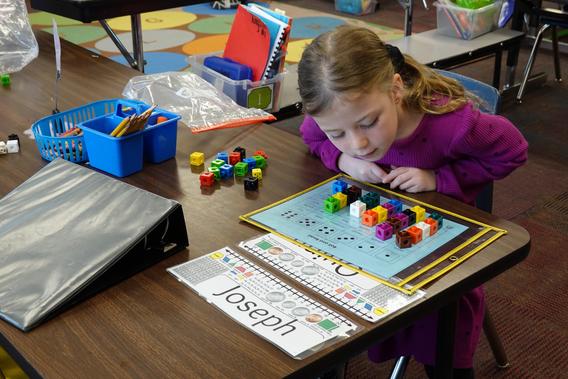Twenty-one UMD education students spent their fall semester at Piedmont Elementary School. Their mission? Helping students learn to read through targeted interventions.
It was an indelible experience for the future teachers—none of whom had been in the classroom before. “They are fully immersed,” says Annette Romualdo, assistant professor and UMD student supervisor. “It’s a full-time experience to ensure they are fully prepared to be the best educators within the state.”
UMD Department of Education faculty worked closely with Piedmont Elementary school leadership and teachers to identify and prioritize shared points of interest for this new and ongoing collaboration. “All parties have a shared interest in providing the best public education we can,” says Eric Torres, head of UMD's Department of Education.

UMD faculty have committed to helping Piedmont improve student academic performance in reading and math. Reading interventions started in the fall. According to Torres, teacher candidates begin with a general theoretical framework and an idea of what it means to be an effective reading teacher. “We’re putting theory and practice together to support each other,” he says.
The UMD preservice teachers were paired with seasoned Piedmont mentor teachers to guide them. Students performing below grade level were identified for focused reading interventions.
A typical Piedmont class size is 22. This means individualized student attention is powerful. “Our students have significant needs—not just academic but social and emotional—especially after COVID,” says Jenna Amundson, a Piedmont teacher helping to lead the partnership. “Having extra support to meet these needs is life-changing for them.”
Evidence-based teaching
As UMD and Piedmont continue this collaboration, the plan is to add math interventions. This is a unique learning opportunity for the education students. “We’re preparing educators who will have had almost 500 hours of experience before they even go into student teaching—that's huge,” says Romualdo.

Hana Schroeder, a third-year Integrated Elementary Special Education major, was placed with Piedmont’s reading interventionist in the fall. She was gratified to witness marked improvement within a month among young readers.
Schroeder also learned simple and effective classroom management techniques that she intends to integrate into her eventual classroom. “Yes, we learned a lot in the classroom at UMD but there’s nothing like going out and experiencing things firsthand. What I learned in the field will stick with me … It was very beneficial,” she says.
The partnership has a shared goal of continuous improvement. Several times a year, Piedmont students are assessed to determine their growth. Student progress data will inform the development and implementation of evidence-based teaching practices moving forward.
Torres notes that there’s serious enthusiasm behind this collaboration and suggests this model could be replicated in other area schools. “Everyone's heart is in it, and we can see the potential of this partnership proving to be greater than we anticipated,” agrees Amundson.
Student Perspective
UMD Integrated Elementary and Special Education students Nathan Svestka and Savannah Lowe talk about their experience working with Piedmont Elementary.
Feature photo (L to R): Piedmont Principal Beth Shermoen, Nathan Svestka (UMD student), Assistant Professor Michael Young, Savannah Lowe (UMD student), and Jenna Amundson, Piedmont teacher.
